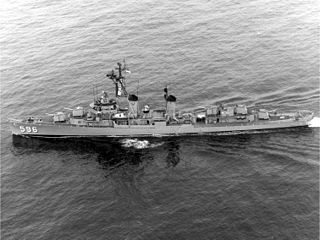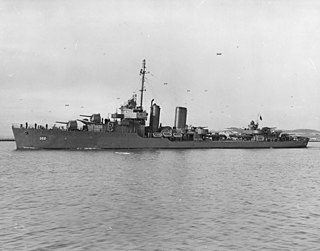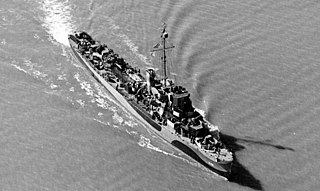
USS Arnold J. Isbell (DD-869), a Gearing-class destroyer, was the only ship of the United States Navy to be named for Arnold J. Isbell, an aircraft carrier captain during World War II. The ship was laid down on 14 March 1945 at Staten Island, New York, by Bethlehem Mariners Harbor, launched on 6 August 1945 and commissioned on 5 January 1946. Constructed too late to see action in World War II, the vessel initially served as a training ship with the United States Atlantic Fleet, before transferring to the Pacific and deploying to Korea during the Korean War and off the Vietnam coast during the Vietnam War. In 1972 Arnold J. Isbell was made part of the reserve training fleet and in 1974, sold to Greece where the ship was renamed Satchouris and served with the Hellenic Navy until being sold for scrap in 2002.

USS Brinkley Bass (DD-887) was a Gearing-class destroyer in service with the United States Navy from 1945 to 1973. She was then transferred to Brazil where she served as Mariz e Barros (D-26) until 1997. The destroyer was finally sunk as a target in 2000.

USS Duncan (DD-874) was a Gearing-class destroyer of the United States Navy, the third named for Captain Silas Duncan USN (1788–1834). The ship was laid down by the Consolidated Steel Corporation at Orange, Texas on 22 May 1944, launched on 27 October 1944 by Mrs. D. C. Thayer and commissioned on 25 February 1945. The ship was sunk in 1980.

USS Vammen (DE-644) was a Buckley-class destroyer escort of the United States Navy.

USS Killen (DD-593), was a Fletcher-class destroyer of the United States Navy.

USS Agerholm (DD-826) was a Gearing-class destroyer of the United States Navy. She was the only ship named for Harold Crist Agerholm, a Private First Class (Pfc.) in the 2nd Marine Division of the United States Marine Corps. He was killed during the assault on Saipan, and posthumously awarded the Medal of Honor.

USS Haraden (DD-585), a Fletcher-class destroyer, was the second ship of the United States Navy to be named for Jonathan Haraden (1744–1803), a privateer of the American Revolutionary War.

The second USS Dixie (AD-14) was the first of her class of destroyer tender built just before the start of World War II for the U.S. Navy. Her task was to service destroyers in, or near, battle areas and to keep them fit for duty.

USS Kane (DD-235/APD-18) was a Clemson-class destroyer in the United States Navy during World War II. She was the first ship named for Elisha Kent Kane.

USS Hart (DD-594), a Fletcher-class destroyer, was the second ship of the United States Navy of that name, in honor of Lieutenant Patrick H. Hart (1912–1942), who posthumously received the Navy Cross for heroism during the Battle of Midway.

USS Metcalf (DD-595), was a Fletcher-class destroyer of the United States Navy named for James Metcalf, who served on the schooner USS Enterprise during the First Barbary War.

USS Shields (DD-596), was a Fletcher-class destroyer of the United States Navy.

USS Brownson (DD-518) was a Fletcher-class destroyer of the United States Navy commissioned on 3 February 1943. She was sunk by Japanese aircraft off Cape Gloucester, New Britain on 26 December 1943.

The third USS Worden (DD-352) was a Farragut-class destroyer in the United States Navy during World War II. She was named for John Lorimer Worden.

USS Watts (DD-567) was a Fletcher-class destroyer of the United States Navy.

USS Walton (DE-361) was a John C. Butler-class destroyer escort in the United States Navy. It was named after Merrit Cecil Walton, a Marine Corps platoon sergeant with the U.S. 1st Marine Division, who died on Gavutu during the Battle of Guadalcanal and was posthumously awarded the Navy Cross for "extraordinary heroism".

USS George W. Ingram (DE-62/APD-43), a Buckley-class destroyer escort in service with the United States Navy from 1943 to 1947. In 1967, she was transferred to Taiwan. She served as Kang Shan until being scrapped in 1979.

USS William C. Cole (DE-641) was a Buckley-class destroyer escort of the United States Navy, named in honor of Vice Admiral William C. Cole (1868–1935).

USS Paul G. Baker (DE-642) was a Buckley-class destroyer escort in service with the United States Navy from 1944 to 1946. She was scrapped in 1970.

USS Ringness (APD-100) was a Crosley-class high speed transport that served in the United States Navy from 1944 to 1946. After spending 29 years in reserve, she was sold for scrapping in 1975.




















